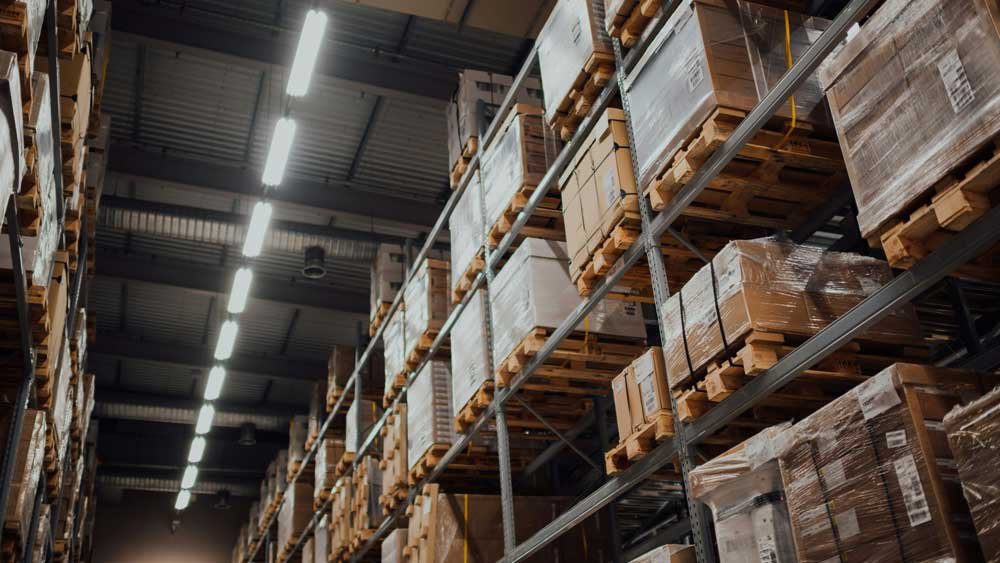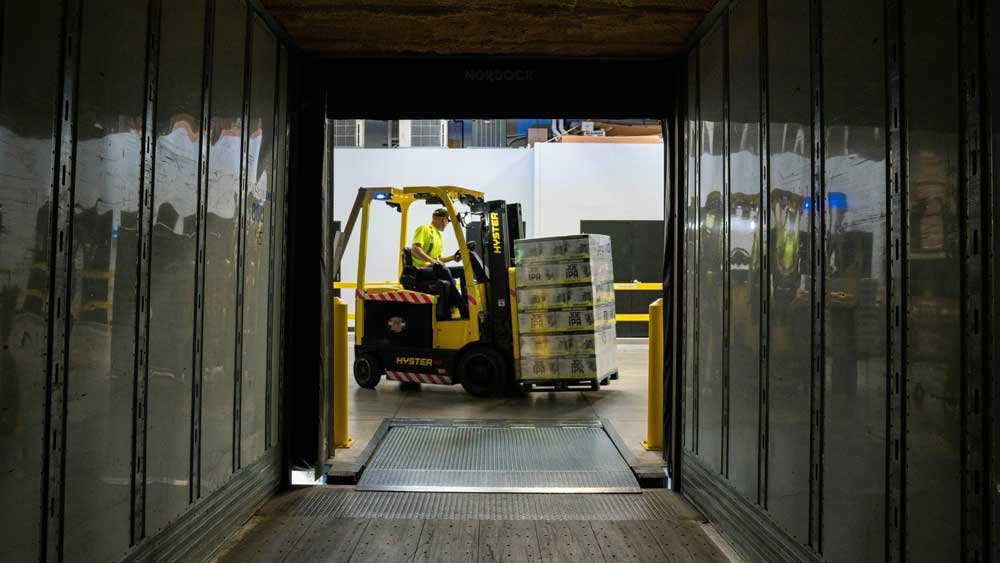In our warehouse management, both static loads and dynamic loads are very important. Because their presence will help us to decide a lot of things like efficiency of warehouse operations, selection and use of pallets and matching of equipment with operations and so on.
So, if you are learning about warehouse management, then I think static loads and dynamic loads in warehouses are one of the things you must know.
What are static and dynamic loads?
What is static loading?
Static load refers to the maximum weight that an object or pallet can bear when it is stationary. In simple terms, it is the weight a pallet can support when the goods are placed on it without any movement.
For example, if you place a pile of goods on a pallet and leave it stationary, the pallet must bear the weight of those goods. This is the static load. The static load limit of a pallet tells us how much weight it can safely carry without being crushed or damaged.

What is dynamic loading?
Dynamic load refers to the maximum weight that a pallet can bear during handling or movement. Unlike static loading, dynamic loading considers the additional forces and shocks that a pallet might experience during movement.
For example, when you use a forklift or trolley to move a pallet, the pallet not only bears the weight of the goods but also experiences forces such as vibrations, acceleration, or sudden stops caused by the movement. These forces make the loading condition of the pallet more complex, which is why dynamic load is typically higher than static load.
In short, dynamic load is the weight a pallet can support during handling, considering possible extra shocks and instability during the process.

What are the physical differences between the two?
The physical differences between static and dynamic loads mainly lie in the forces they bear and how they are applied.
Physical characteristics of static load:
- Static load refers to the weight or force an object bears while at rest. “At rest” here means there is no motion and no acceleration.
- In a static situation, the pallet only bears the gravitational force from the vertical direction, which is the weight of the goods. The force is evenly distributed, and there are generally no additional vibrations or accelerations.
- Simply put, static load is the stable, constant weight that the pallet bears.
Physical characteristics of dynamic load:
- Dynamic load considers the situation when the object is in motion. It includes not only the weight of the goods on the pallet but also the additional loads caused by acceleration, deceleration, vibrations, and impacts during movement.
- When the pallet is being moved, the acceleration and deceleration actions of the forklift or trolley apply extra forces to the pallet, generating shock forces and inertial forces. For example, when the pallet suddenly stops or turns, it experiences a short-term change in force, and these variations increase the total load the pallet must bear.
- Dynamic load is usually higher than static load because the object experiences additional forces during motion.
How do static and dynamic loads affect warehouse structure and equipment selection?
Impact on Warehouse Structure
Static Load:
- When designing the warehouse floor and shelving, static load determines the maximum weight each area and each shelf can bear. The floor must be strong enough to support the weight of goods that are stored stationary for long periods. For example, the floor’s load-bearing capacity must be sufficient to prevent subsidence or cracking due to the weight of stacked goods.
- For heavy-duty shelves, static load also determines how much weight each pallet can bear, which is crucial for the material and structural design of the shelving.
Dynamic Load:
- The warehouse structure needs to account for the dynamic loads that pallets, shelves, and the floor may experience during handling. This means the floor, shelving, and supporting structures must be able to withstand the shocks and vibrations produced by forklifts or trolleys during acceleration, deceleration, and turns.
- Dynamic loads affect the choice of floor materials. For instance, the warehouse floor might need to be reinforced or made of more durable materials to withstand the additional shock forces generated by equipment like forklifts.
- The design of warehouse aisles also needs to take dynamic loads into account. Spacious, smooth aisles can help reduce vibrations during handling and minimize the structural impact.
Impact on Equipment Selection
Static Load:
- Static load directly affects the selection of pallets. Warehouse managers need to choose the appropriate pallet based on the weight of the goods to ensure the pallet can safely bear the load when stationary.
- Static load also affects the selection of equipment such as forklifts and stackers. The maximum load-bearing capacity of the equipment must match the static load to avoid overloading during loading and unloading.
Dynamic Load:
- Dynamic load requires that handling equipment (such as forklifts and pallet trucks) be designed to handle the additional impacts that occur during transportation. For example, forklifts need to have sufficient stability and shock absorption to reduce the impact on both the goods and the equipment during heavy load handling.
- Dynamic loads also require that the equipment can distribute the weight evenly during movement. The lifting capacity and stability of the forklift must consider dynamic loads to ensure that the goods do not slide off or the equipment does not lose control during high-speed driving or turning.
- When designing automated equipment (such as automated stackers or conveyor belts), dynamic loads will also impact the durability and design of the equipment. For example, automated systems need to consider the vibrations and shock forces that may occur during the handling process, influencing the choice of materials and structural design.
How to Quantify Static and Dynamic Loads?
Quantifying static and dynamic loads is crucial to ensure that warehouse equipment and structures can withstand different operational loads. This can generally be achieved through the following steps:
Quantifying Static Load:
Static load is typically quantified by measuring or calculating the weight of the goods. This is a relatively simple process, as the goods are only subjected to gravitational force when stationary.
Calculation Method:
- Measure or estimate the weight of the goods:
First, the weight of the goods needs to be known. If the weight is known, it can be used directly. If not, it can be calculated by using the volume and density:
Weight of goods=Volume×Density (kg/m³) - Calculate the maximum static load of the pallet:
Each pallet has a maximum static load-bearing capacity based on its material, design, and dimensions. This value is typically provided by the manufacturer.
Example: If a pile of boxes is placed on a pallet, and each box weighs 20 kg, with 10 boxes on the pallet, the static load of the pallet would be:
Static Load=20kg×10=200kg
Quantifying Dynamic Load:
Dynamic load is more complex than static load because it involves the additional forces that the pallet experiences during handling. Quantifying dynamic load requires considering not only the weight of the goods but also the speed, acceleration, and shock forces during handling.
Calculation Method:
- Consider inertial force:
Dynamic load must account for the inertial force when the pallet accelerates or decelerates. According to Newton’s second law (F = ma), force equals mass (m) multiplied by acceleration (a).
Assuming the total mass of the pallet and goods is mmm, and the acceleration of the handling equipment (such as a forklift) is aaa, the increase in dynamic load would be:
Dynamic Load Increase=Mass×Acceleration - Consider impact force:
During handling, particularly when abrupt braking or turning occurs, the pallet may experience large impact forces. Impact forces are usually estimated through experiments or by using Finite Element Analysis (FEA) to simulate them.
The impact force can be estimated as:
Impact Force=Mass×Acceleration(assuming acceleration is negative for deceleration)
Example: Assuming the total mass of a pallet and goods is 200 kg, and the forklift’s acceleration is 1 m/s², the increase in dynamic load would be:
Dynamic Load Increase=200 kg×1 m/s²=200 Newtons (N)
Combination of Static and Dynamic Loads:
In practical applications, the equipment and structure used in warehouses need to account for both static and dynamic loads simultaneously. For example, shelves must be designed to handle the weight of stationary goods, while also being able to withstand additional shock forces and vibrations generated during movement.
- Static Load:
Primarily affects the design of floors, shelves, and pallets to ensure that the maximum load-bearing capacity is not exceeded when the goods are stationary. - Dynamic Load:
Affects the selection and design of handling equipment (such as forklifts, conveyor belts, etc.) to ensure that it can withstand the additional forces generated during handling.
Tools and Methods for Quantifying Loads in Practice:
- Sensors and Measurement Equipment:
Load sensors, torque sensors, or accelerometers can be used to monitor dynamic loads in real time. These devices can measure the forces and accelerations that goods experience during handling. - Simulation Software:
By using Finite Element Analysis (FEA) software, the effects of static and dynamic loads can be simulated, and design solutions can be optimized.
What Accidents Can Result from Ignoring Load Design?
Shelf Collapse or Damage:
- Excessive Static Load:
If the design of the shelves does not account for the static load (i.e., the weight of the goods) or if the goods stored on the shelves exceed their maximum weight capacity, the shelves may collapse. This can lead to damage to the goods, equipment, and even cause injuries to personnel. - Excessive Dynamic Load:
If equipment used during handling exceeds the shelf’s load capacity, the shelf may lose balance due to shock forces or uneven loading, leading to a collapse.
Equipment Failure or Damage:
- Forklift or Stacker Damage:
If the load capacity of forklifts or stackers does not consider dynamic loads (such as additional forces generated when accelerating, decelerating, or turning), the equipment may fail due to overload, causing breakdowns or downtime. - Pallet Breakage:
Improper design of static and dynamic loads on pallets can cause them to crack or break during handling. This can lead to goods falling, damage to equipment, or injuries.
Goods Falling or Being Damaged:
- Improper Static Load Design:
If the pallet is overloaded or if goods are not stacked securely, goods may fall or be damaged. This not only wastes inventory but can also lead to serious safety issues. - Dynamic Load Effects:
During handling, if goods are not properly secured or the pallet is subjected to excessive shock forces, goods can fall or be damaged, resulting in losses and injuries.
Personnel Injuries:
- Shelf Collapse or Falling Goods:
If shelves are not designed to handle static loads properly, or dynamic loads are ignored during handling, a shelf collapse or falling goods can directly harm workers or operators, leading to severe injuries or even fatalities. - Forklift Loss of Control:
Ignoring dynamic loads can cause a forklift to lose control when moving at high speeds or making sudden stops, increasing the risk of injury to the operator.
Warehouse Floor Damage:
- Excessive Static Load:
If the warehouse floor is not strong enough to bear the static load, prolonged storage of heavy goods may lead to floor settlement, cracking, or even collapse, affecting the stability of the warehouse. - Dynamic Load-Induced Floor Damage:
If dynamic loads are too large, especially from forklifts or other handling equipment moving at high speeds, the floor may suffer impact damage, leading to wear or degradation, which can affect equipment performance and personnel safety.
Decreased Work Efficiency:
- Frequent Equipment Failures:
Equipment subjected to excessive dynamic loads during handling may experience frequent failures, leading to operational delays, increased repair costs, and reduced work efficiency. - Inventory Management Chaos:
Poorly designed shelves may lead to unstable storage of goods, affecting inventory management and sorting efficiency. This increases operational complexity and reduces warehouse productivity.
Impact on Goods Quality and Integrity:
- Shock or Vibration:
Goods, especially fragile items or precision equipment, may suffer excessive vibration or shock during handling if dynamic loads are not considered. Excessive shock forces can cause goods to be damaged, reducing their quality, or even rendering them completely unusable.
Warehouse Structure Damage:
- Overloading of Shelves and Floors Over Time:
If the warehouse’s shelves, floors, and other structural elements do not adequately account for static and dynamic loads, long-term overload can cause structural fatigue and damage. Ultimately, this could require large-scale repairs or even compromise the entire warehouse’s functionality.
How to Mitigate Load Risks Through Materials and Technology?
Choose High-Strength Materials
- Durable Pallet Materials:
- Steel Pallets: Steel has an exceptionally high load-bearing capacity, making it suitable for heavy-duty storage. Steel pallets can withstand large static and dynamic loads and are less prone to damage.
- Wooden Pallets: Opting for sturdy hardwood (e.g., oak) instead of softwood can enhance the pallet’s ability to handle both static and dynamic loads.
- Plastic Pallets: Materials like high-density polyethylene (HDPE) or polypropylene (PP) provide lightweight, corrosion-resistant pallets. Modern plastic pallets can offer similar load-bearing capacities to wooden pallets, with better resistance to environmental moisture.
- Rack Material Selection:
- Steel Racks: Steel is commonly used for racks due to its excellent compression and bending strength. Using high-quality steel ensures the rack can bear large static loads.
- Aluminum Alloy Racks: Lightweight and corrosion-resistant, aluminum racks are suitable for lighter loads. Though their load capacity is lower, they are perfect for storing less heavy items.
- Floor Materials:
- Concrete: High-strength concrete floors can withstand substantial static loads and are durable. Regularly inspect concrete floors for cracks and settling to ensure they remain level.
- Epoxy Resin Floors: These floors offer wear resistance and help absorb shock from equipment like forklifts, reducing the impact force.
Utilize Advanced Technologies for Load Monitoring
- Smart Sensors: Installing load sensors on pallets, racks, and equipment allows for real-time monitoring of both static and dynamic loads. Through intelligent monitoring systems, operators can track the weight on each pallet or rack, promptly detecting any overload risks to prevent accidents.
- Weight Detection Systems: Some automated warehouse systems are equipped with weight detection systems that measure the load during transport, ensuring handling equipment does not operate under excessive load conditions.
Design and Optimize Rack Structures
- Adjustable Rack Designs: Modern warehouses use adjustable rack systems that can be configured according to the weight and size of the goods. This flexibility allows for proper distribution of the load capacity of each rack based on actual needs.
- Reinforced Rack Supports: Strengthening rack designs, such as adding vertical support columns or thickening beams, can significantly improve the load-bearing capacity and reduce the risk of instability from excessive static loads.
Use Shock Absorption Technology and Materials
- Shock Pads and Cushioning Materials: Placing shock-absorbing pads or cushioning materials between pallets and racks can effectively absorb the impact force caused by dynamic loads. This is especially helpful when handling fragile items, significantly reducing the risk of damage from shock.
- Forklift Shock Absorption Systems: Utilizing shock-absorbing technologies (such as airbags or rubber mats) on forklifts and stackers reduces impact force during operation, lowering the risk of damage to goods and equipment.
Optimize Handling Equipment
- High-Efficiency and Stable Forklifts and Stackers: Choose forklifts, stackers, and other material handling equipment with high load-bearing capacity to ensure they can handle larger dynamic loads during transport. The stability and handling performance of the equipment are crucial to reducing load risks.
- Automated Equipment: Automated systems like automated stackers and forklifts can precisely control acceleration, deceleration, and turning angles, minimizing impact forces. These systems can optimize the handling process by preset parameters, avoiding excessive shock and vibration.
Enhance Cargo Securing and Safety Measures
- Anti-Slip Pallets and Racks: Implementing anti-slip designs on pallets helps ensure that goods do not shift or fall off during handling. This reduces the risks posed by dynamic loads, especially when turning or stopping abruptly.
- Cargo Strapping: For bulk goods, use strapping, tightening nets, or other securing tools to firmly fasten the goods to the pallet, preventing them from moving or falling off during transport.
Training and Operational Standards
- Operator Training: Train operators to enhance their awareness of load risks and ensure they follow proper procedures to prevent overloading or mishandling.
- Establish Strict Handling Guidelines: Develop operational guidelines that limit the load on each piece of equipment, ensuring pallets and racks are not subjected to loads beyond their designed static and dynamic capacity.
Regular Inspections and Maintenance
- Regular Equipment and Structural Inspections: Perform routine checks on warehouse equipment (e.g., pallets, racks, forklifts) and the warehouse structure (e.g., floors, rack supports) for load-bearing conditions. Repair or replace any damaged equipment or structures in a timely manner to avoid overload risks.
- Rack and Floor Inspections: Inspect racks’ stability and floor integrity regularly, particularly after prolonged use or high-intensity operations, ensuring the warehouse facilities are in optimal condition.
Legal Requirements for Warehouse Loads in Different Countries and Regions
United States (OSHA – Occupational Safety and Health Administration)
- OSHA Standards: The U.S. Occupational Safety and Health Administration (OSHA) has a series of regulations concerning warehouse safety, particularly focused on the impact of load on worker safety. According to OSHA regulations, warehouse load capacities must meet certain standards to prevent accidents caused by overload.
- Rack and Floor Design: The design and use of racks must comply with ANSI/RMI (American National Standards Institute/ Rack Manufacturers Institute) guidelines to ensure racks can withstand specified static and dynamic loads. Warehouse floors must also support the weight of equipment and goods, preventing subsidence or collapse.
- Forklifts and Handling Equipment: Handling equipment (e.g., forklifts) must be designed and used according to specific guidelines, with maximum load capacities clearly marked. Overloading is prohibited.
- Load Monitoring and Labeling: Warehouse equipment must be clearly labeled with load limits, and all handling operations should be performed by trained personnel to avoid overloading equipment.
European Union (EU-OSHA – European Agency for Safety and Health at Work)
- EU Directives: The legal requirements for warehouse loads in the EU are mainly governed by the EU Directive on Work Equipment (2009/104/EC) and the Machinery Directive (2006/42/EC). These directives establish guidelines for the load-bearing capacity of equipment and racks and ensure the safety of warehouse operations.
- Rack and Structure Design: Warehouse designs must comply with European standards such as EN 15512 (Rack Structure Standard), which specifies requirements for the design and use of racks and rack systems. Racks must support both static and dynamic loads and include safety factors in their design.
- Floor Load-Bearing Capacity: Warehouse floors must be able to support the loads from handling equipment and stored goods and should meet the criteria outlined in EN 1991-1-1 (European Building Load Standard).
- Load Monitoring and Labeling: The maximum load capacity of all equipment and structures must be clearly marked, and regular inspections are required to ensure that goods and equipment do not exceed safe load limits.
China
- GB 50072-2017 “Warehouse Design Code”: This is the primary standard in China for warehouse design, load-bearing capacity, and load requirements. It specifies requirements for floor load-bearing capacity, rack design, stacking height, and pallet load.
- Static and Dynamic Load Requirements: Warehouse designs must consider both static and dynamic loads to ensure that racks, equipment, and the overall warehouse structure are not overloaded during storage and handling operations.
- Floor Strength: The warehouse floor must meet specific load-bearing requirements to prevent deformation or subsidence due to overload.
- Forklifts and Handling Equipment: The handling equipment within the warehouse must meet specified load capacities, and overloading during transport is prohibited.
- “Building Structure Load Code” (GB 50009-2012): This code specifies the maximum loads that building structures, including warehouse floors, can safely bear.
Australia (Workplace Health and Safety – WHS)
- WHS Regulations: Australia’s workplace health and safety laws include warehouse load-bearing requirements to ensure all equipment and structures can safely carry the required loads and prevent accidents from overloading.
- Rack and Equipment Design: Racks and pallets must comply with AS 4084 (Australian Standard for Racks and Storage Equipment), ensuring that they can bear specified loads, taking into account dynamic forces during handling.
- Floor Design: Warehouse floors must meet AS 3600 (Concrete Structure Standard) to ensure they remain stable and do not cause accidents due to instability during handling and storage.
Canada (Workplace Safety and Insurance Board – WSIB)
- WSIB Standards: Canada’s WSIB has clear requirements for warehouse loads, ensuring that racks, floors, and handling equipment are designed to safely support the weight of goods and prevent overload.
- Rack and Equipment Design: Racks must comply with CSA S376 (Canadian Standards Association’s Storage Equipment Standard), specifying the maximum load capacities for racks and equipment.
- Load Monitoring: Load sensors and other technologies must be used to monitor the load-bearing state of warehouse equipment, preventing overloading.
Japan
- Building Load Standards: Japan’s Building Design Standards (e.g., Building Standards Act) specify the load-bearing requirements for warehouse floors. The floors must support the loads from equipment, goods, and other static and dynamic forces.
- Rack and Pallet Design: Warehouse racks and pallets must comply with JIS Z 9901 (Japanese Industrial Standards) to ensure they can safely support the required loads.
Other Regions
Many other countries and regions also have similar warehouse design standards and legal requirements, typically regulated by national standards organizations or international bodies like the International Organization for Standardization (ISO). For example, international standards such as ISO 14721 and ISO 14122 provide guidance on warehouse equipment and operations.
Conclusion
After reading this article, you should have a clearer understanding of the legal requirements related to static and dynamic loads in warehouses. As I mentioned earlier, both types of loads are crucial to warehouse management, and safety must be a top priority to prevent accidents. Always double-check load-bearing capacities when addressing safety concerns in warehouse operations.

